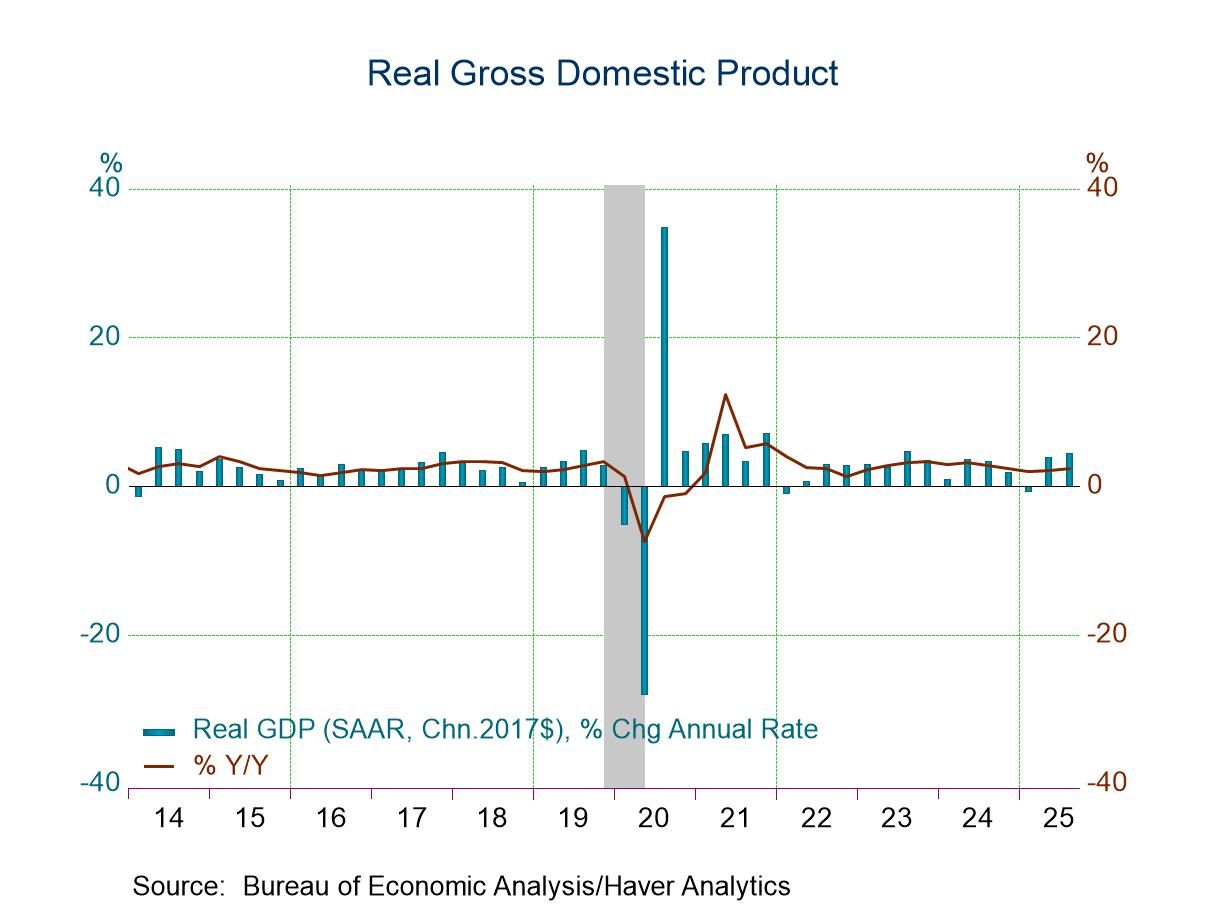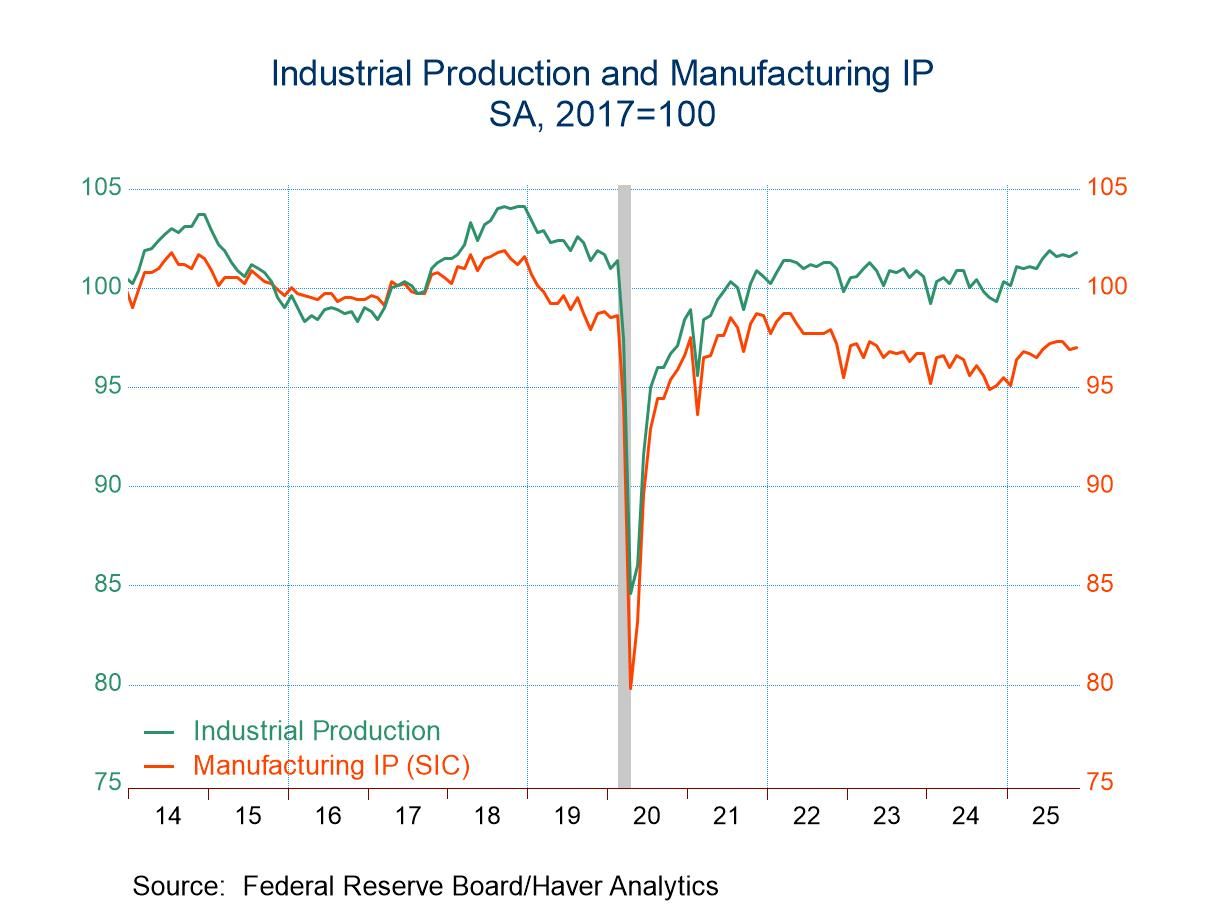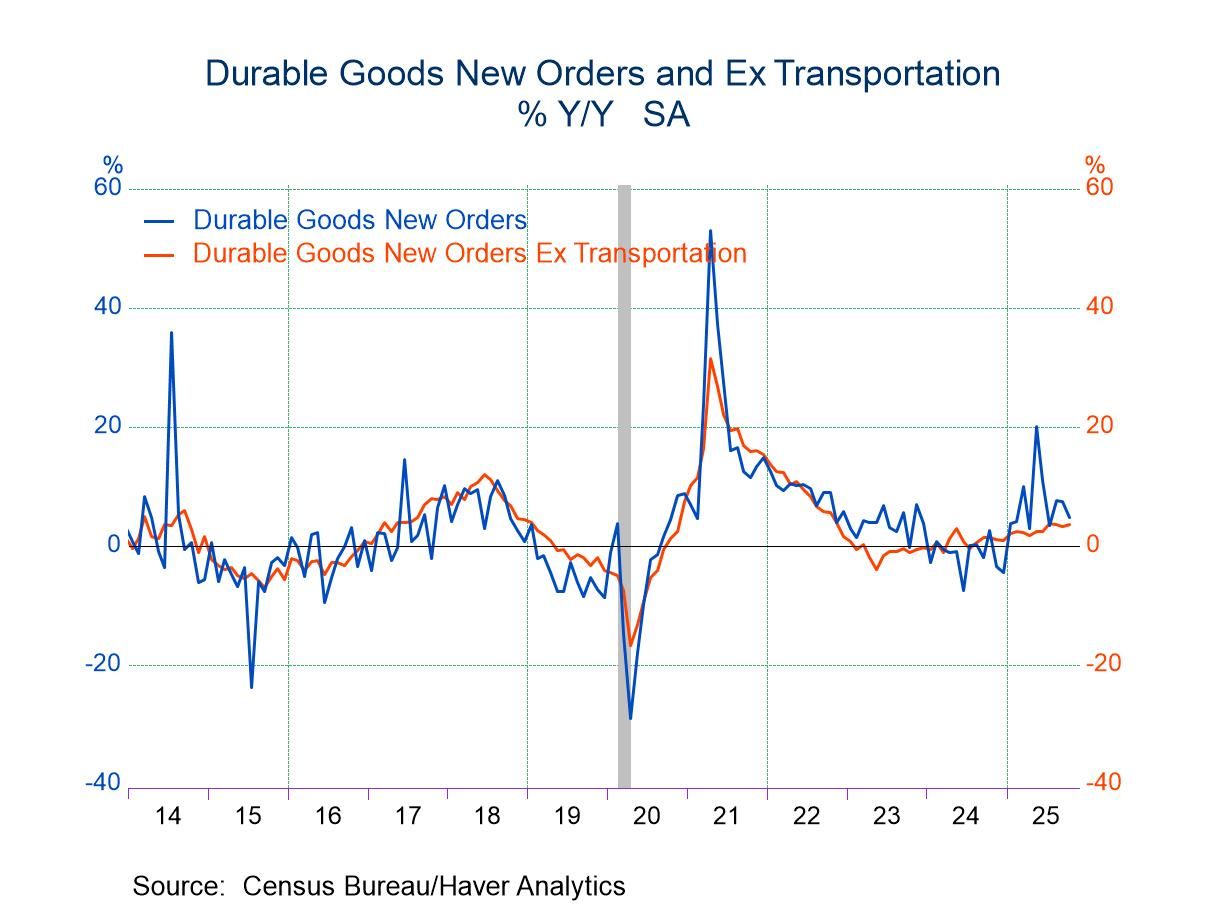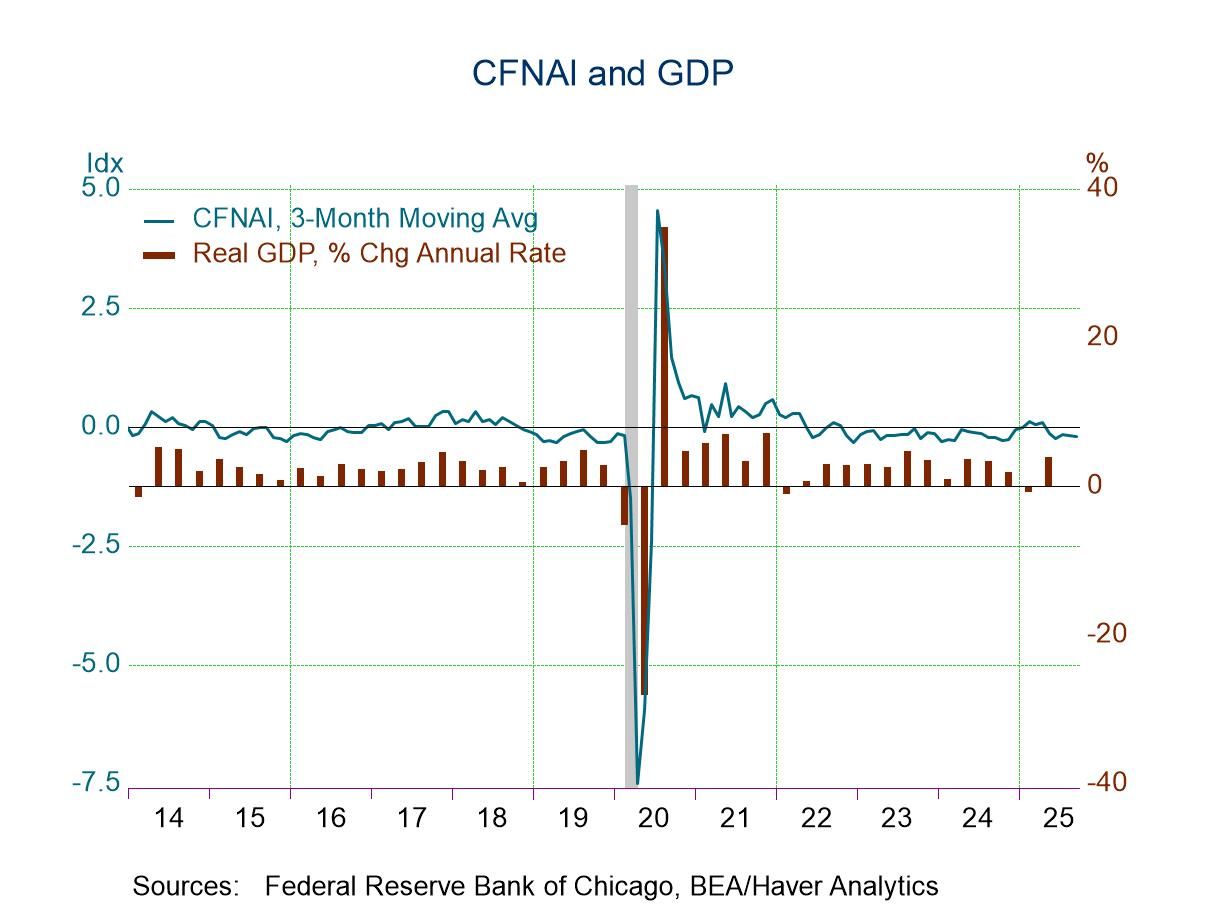 Global| Feb 27 2020
Global| Feb 27 2020U.S. GDP Growth Is Unrevised
by:Tom Moeller
|in:Economy in Brief
Summary
The U.S. economy grew 2.1% (SAAR) during the fourth quarter of 2019, unrevised from the advance estimate. The gain roughly matched growth during the prior two quarters and equaled expectations in the Action Economics Forecast Survey. [...]
The U.S. economy grew 2.1% (SAAR) during the fourth quarter of 2019, unrevised from the advance estimate. The gain roughly matched growth during the prior two quarters and equaled expectations in the Action Economics Forecast Survey.
Growth in domestic final demand was lessened slightly to 1.5% (2.3% y/y) from 1.6%. It remained the slowest rise since Q4'18 and was down from a 4.9% peak in Q4'17.
The increase in personal consumption expenditures was lessened to 1.7% (2.6% y/y), a sharp deceleration from growth during the prior two quarters. Spending growth on durable goods was raised slightly to 2.6% (5.9% y/y) as motor vehicle expenditures grew 5.5% (3.0% y/y), much improved from the 0.8% gain estimated last month. Recreational vehicle purchases grew a lessened 1.7% (12.0% y/y) and growth in furniture & appliance purchases also decelerated to a reduced 1.1% (4.5% y/y). Nondurable goods purchases fell 0.3% (+3.0% y/y), lessened from +0.8%. Growth was held back by declines in spending on food & beverages and "other" products. Apparel purchases increased a reduced 4.8% (3.1% y/y) and gasoline & other energy product purchases fell 0.7% (-0.1% y/y), revised from +4.7%. Consumer spending on services increased a steady 2.2% (2.0% y/y). Outlays on housing & utilities rose a lessened 0.2% (0.9% y/y) and spending growth at restaurants fell to 1.3% (2.0 y/y). Growth also slowed for transportation services to a lessened 0.2% (3.1% y/y), but recreation growth was little changed at 2.7% (2.0% y/y). Health care outlays increased a strengthened 3.8% (3.5% y/y), the best gain in three quarters.
Business fixed investment fell at a 2.3% rate (-0.3% y/y), which was deepened from -1.5% and down for the third consecutive quarter. The weakness was paced by a 8.1% drop (-6.5% y/y) in building outlays, which remained on par with the declines in three of the prior four quarters. The decline in equipment investment was deepened to 4.4% (-1.9% y/y) from -2.9% (-1.5% y/y), down for the third quarter in the last four. A sharp 12.6% decline (-2.2% y/y) in industrial equipment investment was accompanied by an improved 0.8% rise (2.3% y/y) in information processing equipment. Intellectual property product investment rose 4.0%. Growth of 5.7% y/y remained below the peak of 9.6% early in 2019.
Residential investment rose a little-changed 6.1% (1.6% y/y), the second quarter of improvement after falling for the last two years.
Government spending growth rose to 2.6% q/q, close to the prior estimate. It left y/y growth at 3.0%, the strongest rise since 2009. Federal government spending rose 3.8% (4.4% y/y) bolstered by a 5.3% strengthening of defense outlays. During all of 2019, defense spending rose 4.9%, the quickest growth in ten years and improved from declines early in the decade. Nondefense outlays rose 4.1% y/y, the quickest growth since 2012. State & local investment also rose an improved 2.2% y/y, up from 0.6% in 2017.
Holding back economic performance was inventory liquidation which subtracted 1.0 percentage point from GDP growth, revised from 1.1 points. Offsetting this drag was an unrevised 1.5 percentage point addition to growth from a smaller foreign trade deficit. Exports of goods & services rose an improved 2.1% (0.3% y/y) while imports declined 8.6% (-2.2% y/y).
Pricing power remained under control as the GDP price index rose a lessened 1.3% (1.6% y/y). An unchanged 1.4% had been expected. The PCE price index rose a lessened 1.3% (1.4% y/y) and prices excluding food & energy were up 1.2%, revised from 1.3%, leaving y/y growth a reduced 1.6%. The change in the business fixed investment price index was raised to 0.5% (1.2% y/y) from -0.2%. The residential investment price index rose 2.6%, revised from 2.7%, and an unchanged 2.6% y/y.
The GDP figures can be found in Haver's USECON and USNA database. USNA contains virtually all of the Bureau of Economic Analysis' detail in the national accounts. Both databases include tables of the newly published not seasonally adjusted data. The Action Economics consensus estimates can be found in AS1REPNA.
U.S. Economic Outlook and Monetary Policy from Fed Vice Chair Richard H. Clarida is available https://www.federalreserve.gov/newsevents/speech/clarida20200225a.htm
Q4'19 (Second Estimate)
Kansas City Fed Factory Indexes Increase The Federal Reserve Bank of Kansas City reported that its
index of regional manufacturing business activity rose to 5 in February
following January's improvement to -1. This indicates renewed expansion in
factory sector activity. The index of expectations in six months rose to 16 and
added to the prior month's gain. The ISM-Adjusted Index increased to 52.7 (NSA) in February.
It was the first reading above the break-even level of 50 following seven
straight months below 50. The current condition components of the survey exhibited
mixed performance with new orders, shipments and production increasing. The
employment index, however, returned to negative territory. The export measure
turned positive after eight straight negative numbers. The employee workweek
measure remained negative for the fourth straight month. On the inflation front, prices received for finished products
rose for the first time in three months. Raw materials prices, however,
increased at a slower rate. The index measuring expectations in six months rose with a
gain in new orders, recovering declines in the prior two months. The expected
employment measure held steady and production dipped. Expected export orders
surged to the highest level in six months. Expected finished product prices rose sharply but remained
down y/y. Expected raw materials prices moved up slightly but were down y/y. The diffusion indexes are calculated as the percentage of
total respondents reporting increases minus the percentage reporting declines.
The December survey included 93 responses from plants in Colorado, Kansas,
Nebraska, Oklahoma, Wyoming and northern New Mexico and was conducted in the
period from December 11-16, 2019. Data for the Kansas City Fed Survey can be
found in Haver's SURVEYS database.
by Tom
Moeller February 27, 2020
Kansas City Federal Reserve
Manufacturing Survey (SA)
Feb
Jan
Dec
Feb'19
2019
2018
2017
Conditions Versus One Month Ago (%
Balance)
5
-1
-5
0
0
17
14
ISM-Adjusted Composite Index (NSA)
52.7
48.3
43.4
48.5
50.0
58.9
56.7
New Orders Volume
8
-2
-13
-11
-3
17
17
Number of Employees
-4
4
-7
7
-1
17
15
Production
8
-4
-3
-2
2
19
17
Prices Received for
Finished Product
9
-3
-2
16
7
22
7
Expected Conditions in Six Months
16
14
9
14
12
28
26
New Orders Volume
21
9
16
16
17
35
35
Number of Employees
20
20
9
25
15
33
31
Production
21
23
14
20
19
40
40
Prices Received for
Finished Product
28
20
13
34
26
42
27
Tom Moeller
AuthorMore in Author Profile »Prior to joining Haver Analytics in 2000, Mr. Moeller worked as the Economist at Chancellor Capital Management from 1985 to 1999. There, he developed comprehensive economic forecasts and interpreted economic data for equity and fixed income portfolio managers. Also at Chancellor, Mr. Moeller worked as an equity analyst and was responsible for researching and rating companies in the economically sensitive automobile and housing industries for investment in Chancellor’s equity portfolio. Prior to joining Chancellor, Mr. Moeller was an Economist at Citibank from 1979 to 1984. He also analyzed pricing behavior in the metals industry for the Council on Wage and Price Stability in Washington, D.C. In 1999, Mr. Moeller received the award for most accurate forecast from the Forecasters' Club of New York. From 1990 to 1992 he was President of the New York Association for Business Economists. Mr. Moeller earned an M.B.A. in Finance from Fordham University, where he graduated in 1987. He holds a Bachelor of Arts in Economics from George Washington University.






